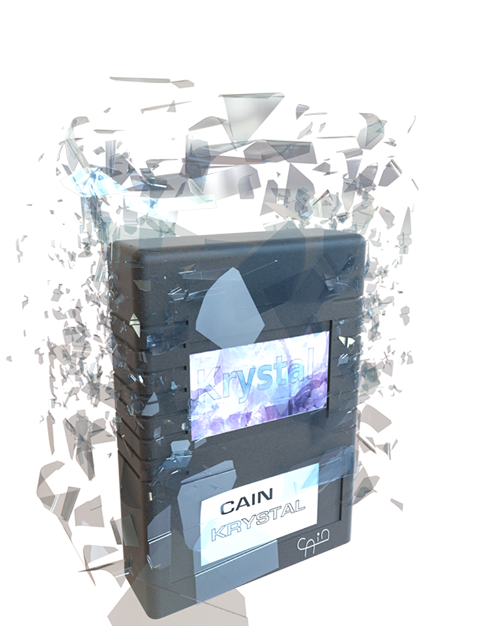
artwork done by

Summary and Features
Do you want to add that extra sparkle to your sound or crush it? The KRYSTAL oscillator adds just that finishing touch to your pads or percussive sounds.
The KRYSTAL features a ‘shatter model’ for the *logue multi engine.
It is a user oscillator, which is capable of capturing the different phases of an object, which is being shattered into pieces.
It can start with the initial chaotic sound, when all the pieces are very close to each other with a chaotic noise. This is where the collision of the objects will disrupt the natural decay of each other.
As we move along the timeline these interactions will be less, so the already shattered pieces will have more time to decay.
I am assuming an infinite room for this, so there will not be a sudden stop phase, where all shards end up on the floor with a thumping, non harmonic sound.
Up to 6 so called crystals can sound simultaneously on one oscillator.
| Parameter | Function | Status |
|---|---|---|
| Shape | Choose a time in the crash event | Implemented |
| Shift Shape | Changes the material by adding overtones. | Implemented |
| User Parameter 1 | AR envelope depth for the time. From (-100 - 100) | Implemented |
| User Parameter 2 | AR envelope release speed. | Implemented |
| User Parameter 3 | Attack time of the crystals. | Implemented |
| User Parameter 4 | Harmonics. Chose different musical (or non-musical) intervals for the crystals | Implemented |
| User Parameter 5 | High Pass Filter to clean out the mud in the mix. | Implemented |
| User Parameter 6 | Decay time for a simple AD envelope. The decay can be 0 (max volume the whole time) or 100 for a fast release time. | Implemented |
With the shape knob you can move through the time line of the crash.
With the alt shape action you can influence the timbre of the crystals.
In addition a simple AR envelope is implemented, which can be applied to the time line on top of the shape knob. Only the release of the envelope can be controlled. The envelope depth, which is the effect on the time line can be adjusted from -100% to + 100%.
The attack time of the individual crystals can be adjusted, to generate a more glass type sound with a long, slow attack, or a crisp short attack.
The generated crystals of one oscillator can vary in pitch. The pitch is selected from one of 12 values randomly. There are 10 sets of pitch values available. Ranging from a simple octave with detune, to major and minor chords, all the way to disharmonic chaos.
Based on a hint, I also implemented a simple high pass filter as well as an AD envelope for fading out the signal, in case you want to combine it with the analog oscillators of the minilogue or prologue.
If you like my work, you have the possibility to show your appreciation by donating.
Here are some ideas on what you could donate if you are thinking…
| “Thank you for your efforts, but I am currently broke. Still I want to support you the best I can.” |
0€ – but please put a link to the unit you used in the comments of your published work
|
| “I’ll buy you a coffee for your efforts” | 2€ |
| “Did I put my pants on before leaving the house?” | 5€ |
| “Improves my minilogue XD by 1 %” | 6€ |
| “Improves my prologue by 1%” | 10€ |
| “I’ll buy you a minilogue XD, so you can work out the details on the parameters for that unit.” | 600€ |
Downloads
Release Version 1.0.1
- Unfortunately you have to adjust the Envelope Mod parameter once to ensure it will react to the shape knob correctly (working on this…)
- Reacting to a user request, I added a simple amplitude-decay to the oscillator.
Here are some ideas on what you could donate if you are thinking…
| “Thank you for your efforts, but I am currently broke. Still I want to support you the best I can.” |
0€ – but please put a link to the unit you used in the comments of your published work
|
| “I’ll buy you a coffee for your efforts” | 2€ |
| “Did I put my pants on before leaving the house?” | 5€ |
| “Improves my minilogue XD by 1 %” | 6€ |
| “Improves my prologue by 1%” | 10€ |
| “I’ll buy you a minilogue XD, so you can work out the details on the parameters for that unit.” | 600€ |
Release Candidate 1
Beta version
User params are:
- Start of the crash (100 is the starting point)
- End of the crash (0 is where only occasional collisions take place)
- Time (Slope of the event)
- HP Filter to clean the mess up (acoustically)